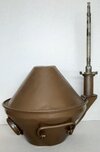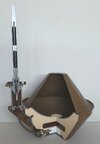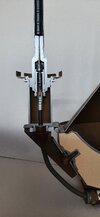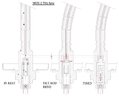The TMK-2 is a shaped charge anti-tank mine. The mine body consists of two conical shaped sheet steel body parts , connected by means of a seam. Between the two body halves, the round shaped charge cone is placed. An explosive charge is cast below the cone through the filler hole on the lower side of the mine body. The booster charge is placed in the center-base of the explosive charge, it consists of a tin of RDX in which a horizontal placed DUM-2 detonator is placed. In the base of the mine body a screwed in cap is placed which allows the booster to be inserted into the mine. It also keeps the base of the mine watertight by means of a rubber O-ring. A wooden wave shaper is cast in with the main charge just above the booster charge; this enshures the detonation wave approaches the cone not from below, but appr. 45 degrees from the side which gives a better armour penetration as nearly the whole cone is consumed at once.
When the mine is TNT filled, it will penetrate a 60mm thick steel plate, when TG-50 filled it will penetrate a 110 mm thick steel plate.
On the side of the mine body a support is attached to the mine body by means of a bolt. A pipe shaped piece placed on top of the support -held in place by a bolt- houses the MVK-2 tilt fuze. At the base of the pipe piece a cable gland is placed which clamps around the detonating cord between the MVK-2 fuze and the DUM-2 detonator.
The MVK-2 fuze is a tilt fuze that is exclusively used on the TMK-2 anti tank mine. The fuze conssists of a fuze housing (1) in which the housing (2) for the firing pin (3) and the dupex detonator (4) is screwed into the base. The firing pin (3) is tensioned by the firing pin spring (4), and is fixated by the two steel locking balls (5) which partially fall in a groove in the firing pin (3) and which are kept in inward position by a bushing (6) which is connected to a steel rod (7). As long as this bushing (6) is kept in lower position, the firing pin (3) is fixated. The rod (7) runs upward in the fuze body and has seven cilinders (8) placed over the rod. The top two centimeters of the rod is threaded, as well as the top cilinder on the inside, and the top cilinder acts as a nut. The cilinders are stacked in an aluminium tube (9). If a tank or vehicle hits the antenna and starts bending it between 24 and 36 degrees, the cilinders will form a hinge on the side they are bent in. This however means that the lenth over the center of the cilinders (8) becomes longer, meaning that the rod will lift the bushing (6) upward (distance D), allowing the steel balls (5) to move outward, releasing the firing pin (3) that hits the duplex detonator. The duplex detonator ignites the detonating cord which ignites the DUM-2 detonator which ignites the mine.
The mine body is completely dug in so only 0,85 mtr of the antenna of the tilt rod fuze is visable above the ground. On all pictures in this posting the top part of the antenna is missing. The top part of the antenna is slided over the lower half. The upper half hovever is an empty pipe that does not contain any parts that are of interest for this posting.
The mine was (and probably still is) not popular amongst the troops as a large hole has to be dug to bury the mine and the mine has the tendencty to rotate when the antenna of the MVK-2 fuze is hit by the hull of a vehicle. This results in the shaped charge being ignited away from the target and missing the target. To prevent this from happening the mine is fixated by placing bricks below and beside it and using wooden wedges to fixate it from rotating. This is however a lot of work compared to tracked mine laying systems where soldiers only have to place a mine on a belt and burrying is done automaticly.
The 50 to 110 mm penetration is also excessive, as the average tank has a bottom plate of between 20 to 30 mm.
Diameter mine body : 307 mm
Height mine body : 265 mm
Height with placed MVK-2 tilt fuze : 1130 mm
Weight mine : 12,5 kg
Weight explosive charge : 6,5 kg TG-50 (RDX/TNT) or 6 kg TNT
Activation pressure : 8-12 kg sideways on antenna
The TMk-2 mine is found in the following countries:
Afghanistan, Angola, Azerbedzjan, Ehthiopia, Mozambique and Namibia.
Regards, DJH
When the mine is TNT filled, it will penetrate a 60mm thick steel plate, when TG-50 filled it will penetrate a 110 mm thick steel plate.
On the side of the mine body a support is attached to the mine body by means of a bolt. A pipe shaped piece placed on top of the support -held in place by a bolt- houses the MVK-2 tilt fuze. At the base of the pipe piece a cable gland is placed which clamps around the detonating cord between the MVK-2 fuze and the DUM-2 detonator.
The MVK-2 fuze is a tilt fuze that is exclusively used on the TMK-2 anti tank mine. The fuze conssists of a fuze housing (1) in which the housing (2) for the firing pin (3) and the dupex detonator (4) is screwed into the base. The firing pin (3) is tensioned by the firing pin spring (4), and is fixated by the two steel locking balls (5) which partially fall in a groove in the firing pin (3) and which are kept in inward position by a bushing (6) which is connected to a steel rod (7). As long as this bushing (6) is kept in lower position, the firing pin (3) is fixated. The rod (7) runs upward in the fuze body and has seven cilinders (8) placed over the rod. The top two centimeters of the rod is threaded, as well as the top cilinder on the inside, and the top cilinder acts as a nut. The cilinders are stacked in an aluminium tube (9). If a tank or vehicle hits the antenna and starts bending it between 24 and 36 degrees, the cilinders will form a hinge on the side they are bent in. This however means that the lenth over the center of the cilinders (8) becomes longer, meaning that the rod will lift the bushing (6) upward (distance D), allowing the steel balls (5) to move outward, releasing the firing pin (3) that hits the duplex detonator. The duplex detonator ignites the detonating cord which ignites the DUM-2 detonator which ignites the mine.
The mine body is completely dug in so only 0,85 mtr of the antenna of the tilt rod fuze is visable above the ground. On all pictures in this posting the top part of the antenna is missing. The top part of the antenna is slided over the lower half. The upper half hovever is an empty pipe that does not contain any parts that are of interest for this posting.
The mine was (and probably still is) not popular amongst the troops as a large hole has to be dug to bury the mine and the mine has the tendencty to rotate when the antenna of the MVK-2 fuze is hit by the hull of a vehicle. This results in the shaped charge being ignited away from the target and missing the target. To prevent this from happening the mine is fixated by placing bricks below and beside it and using wooden wedges to fixate it from rotating. This is however a lot of work compared to tracked mine laying systems where soldiers only have to place a mine on a belt and burrying is done automaticly.
The 50 to 110 mm penetration is also excessive, as the average tank has a bottom plate of between 20 to 30 mm.
Diameter mine body : 307 mm
Height mine body : 265 mm
Height with placed MVK-2 tilt fuze : 1130 mm
Weight mine : 12,5 kg
Weight explosive charge : 6,5 kg TG-50 (RDX/TNT) or 6 kg TNT
Activation pressure : 8-12 kg sideways on antenna
The TMk-2 mine is found in the following countries:
Afghanistan, Angola, Azerbedzjan, Ehthiopia, Mozambique and Namibia.
Regards, DJH




